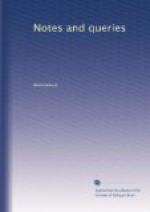What is the meaning of this proverb?
As a confirmation of the opinion of some of your correspondents, that monosyllables give force and nature to language, the same author says, page 59., of the Dutch tongue,—
“Stevin of Bruges reckons
up 2170 monosillables, which being
compounded, how richly do
they grace a tongue.”
Will any of your correspondents kindly inform me of the titles of Owen Feltham’s works. I have his Resolves, and a thin folio volume, 1661, printed for Anne Seile, 102 pages, containing Lusoria, or Occasional Pieces; A Brief Character of the Low Countries; and some Letters. Are these all he wrote? The poem mentioned by Mr. Kersley, beginning—
“When, dearest, I but think of thee,”
is printed among those in the volume I have, with the same remark, that it had been printed as Sir John Suckling’s.
E.N.W. {134}
Eikon Basilice.—
“[Greek: EIKON BASILIKAE], or, The True Pourtraiture of His Sacred Majestae Charles the II. In Three Books. Beginning from his Birth, 1630, unto this present year, 1660: wherein is interwoven a compleat History of the High-born Dukes of York and Glocester. By R.F., Esq., an eye-witness.
“Quo nihil majus meliusve terris
Fata donavere, borique divi
Nee dabunt, quamvis redeant in aurum
Tempora priscum.”
Horat.
“[Greek: Otan tin’ Euraes
Eupathounta ton kakon
ginske touton to telei taeroumenon].”
G. Naz Carm.
“——more than conqueror.”
“London, printed for H. Brome and H. March, at the Gun, in Ivy Lane, and at the Princes’ Arms, in Chancery Lane, neer Fleet Street, 1660.”
The cover has “C.R.” under a crown. What is the history of this volume. Is it scarce, or worth nothing?
A.C.
“Welcome the coming, speed the parting Guest?”
—Whence comes the sentence—
“Welcome the coming, speed the parting guest?”
E.N.W.
Carpets and Room-paper.—Carpets were in Edward III.’s reign used in the palace. What is the exact date of their introduction? When did they come into general use, and when were rushes, &c., last used? Room-paper, when was it introduced?
JARLTZBERG.
Cotton of Finchley.—Can some one of your readers give me any particulars concerning the family of Cotton, which was settled at Finchley, Middlesex, about the middle of the sixteenth century?
C.F.
Wood Carving in Snow Hill.—Can any one explain the wood carving over the door of a house at the corner of Snow Hill and Skinner Street. It is worth rescuing from the ruin impending it.
A.C.
Walrond Family.—Can any of your readers inform me what was the maiden name of Grace, the wife of Col. Humphry Walrond, of Sea, in the county of Somerset, a distinguished loyalist, some time Lieutenant-Governor of Bridgewater, and Governor of the island of Barbadoes in 1660. She was living in 1635 and 1668. Also the names of his ten children, or, at all events, his three youngest. I have reason to believe the seven elder were George, Humphry, Henry, John, Thomas, Bridget, and Grace.




